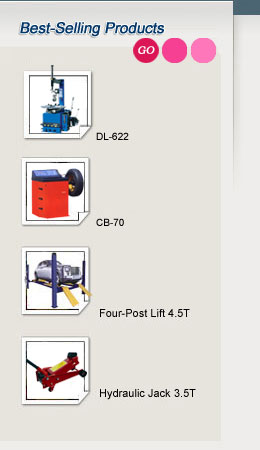Making mention of tire's types, actually there are many ways to classify them: some are classified by structure, some by the sort of vehicle, some by use purpose, and some are classified according to the size, or according to the pattern, or whether having a tube.
¡ñ Classification according to the structure of the tire
According to the structure of the tires, under present using circumstances, tires are divided into bias tires and radial tires.
Radial Tire: The angle between tire curtain line and steel belt cord is almost the same as the meridian of the earth, therefore as the name implies it is called the radial tire.
Bias Tire: The layer and layer among tire curtain line present crossing arrangement, therefore it is called bias tire.
BELTED BIAS: the body structure is the same as the bias, in addition it has steel belt cord.
¡ñClassification according to the type of the automobile
According to the type of the vehicle, generally it can be divided into 8 kinds, they are:
PC¡ª¡ªRadial Tires for Passenger Car
LT¡ª¡ªLight Truck Tire
TB¡ª¡ªTruck/Bus Tire
AG¡ª¡ªAgricultural Tire
OTR¡ª¡ªOff-The-Road Tire
ID¡ª¡ªIndustrial Tire
AC¡ª¡ªAirplane Tire
MC¡ª¡ª Motorcycle Tire
¡ñClassification according to purpose of the tire
According to the uses, tires can be classified into truck tire, passenger tire and mining tire etc. Apart from marks the standard dimension on the sidewall of truck tire, and also must mark the layer. But one thing should be made clear that the ply of the truck tire doesn¡¯t mean its actual layer. Instead it means the tire which is made up of the high-strength cord, is equivalent to the cord layers of the tire which is made up of cotton cord. That is because the cotton cord is the earliest material for making the tire cord, therefore, in international convention, it uses the cotton cord as the benchmarks of the tire cord. Tires with different plies have different loading capacity. Even the tires with same specifications will have different loading capacity if their levels are different. So that tires with different plies cannot be used in the same axle, otherwise the dangerous accident would happen if it is laden and running at a high speed.
In order to distinguish from the PCR tires, for metric series radial light truck tires or conventional section radial light truck tires, a letter C should be added behind the tire size. For instance, the size ¡°185SR14C¡±, ¡°C¡± means it is a light truck tire. But in American tire rules: The passenger tires should add letter ¡°P¡± before the sizes. For example, the size ¡°P215/75R15¡± , ¡°P¡± means it is a passenger tire. Apart from this, the light truck tires sometimes have ¡°LT¡± before or after the tire size to indicate. For example ¡°LT215/75R15¡± and ¡°145R12LT¡±, ¡°LT¡± means it is a light truck tire.
¡ñClassification according to the size of the tire
According to the size of the tire, generally speaking, when the section width is above 17 inch (1inch=25.4mm) , this kind of tire belongs to huge tire£»the section width between 17in and 10in belongs to large tire; and the section width below 10in belongs to middle and small tire.
¡ñ Classification according to the pattern of the tire
According to the pattern, the tire can be divided into many kinds. But generally speaking it can be divided into five kinds.
¢ÙHighway Pattern, it is also called ordinary pattern. The operation invariability of this kind of pattern is good, running resistance is small and low noise. Especially the ability of drainage water is excellent, and it¡¯s not easy to cause transverse slippage.
¢ÚTraction Pattern. For traction pattern, the driving force, braking force and traction force are very excellent. Moreover its wear resistant is excellent, therefore it completely suits for off-the-road vehicles, such as bulldozer and excavator etc. But the operation and draining performance for traction pattern are not so good.
¢ÛMixed Pattern, it is also called synthetical pattern. It has advantage of both highway and traction. So that it is also quite suitable for cross-country vehicles, such as jeeps, etc.
¢ÜMud and Snow Pattern. The mud and snow pattern, just as its name implies, is designed specially for the muddy land and snowy land. It uses the letter ¡°M+S¡± to express, ¡°M¡± refers to the muddy land, and ¡°s¡± refers to the snowy land.
The four kind of basic pattern- the highway pattern, traction pattern, mixed pattern, and block pattern and its characteristic.
¢ÙHighway Pattern: Excellent operation stability /slight rotation resistence noise/ good draining performance /not easy to lateral slippage.
¢ÚTraction Pattern: Excellent driving force, braking force, and traction force / good wear resistance
¢ÛMixed Pattern: It has advantage of both highway and traction.
¢ÜBlock pattern: Both of the driving force and braking force are very good.
¢ÝCross-country Pattern: The cross country pattern is specially designed for the adaptation of dry, wet, rugged mountain road and mud, sand road.
In addition, some patterns have directional character, which take the grip function as their main capability. When stall this kind of tires, please pay attention to according to the mark of rolling direction to install. If it is without mark on the tires, then the tip of the pattern should get to the ground first. But for the tires with directional pattern, if it used in the cross-country vehicle which has the same front and rear wheel width, then the two tires in front wheels could be reversed during installation. After the reverse installation, if you drive on the mud road, then make the front wheels become low which will reduce rolling resistance and save fuel. At the same time, after the front wheels passed, the road will be pressed a little solid, it will be good for the rear wheels passing and improve traction.
¡ñClassification according to whether the tire has tube or not.
Tube tire
Tubeless tire

















